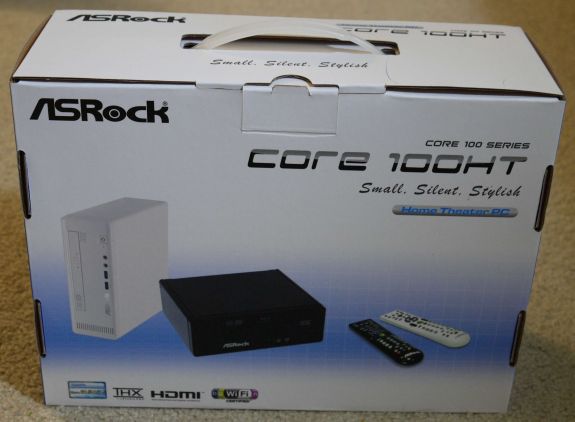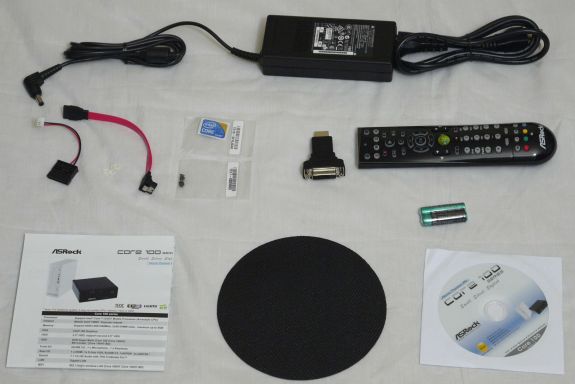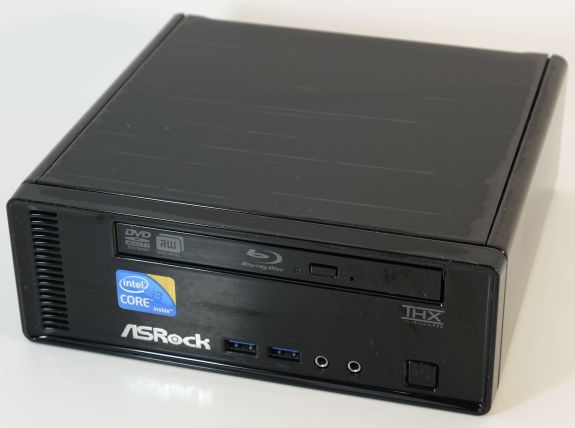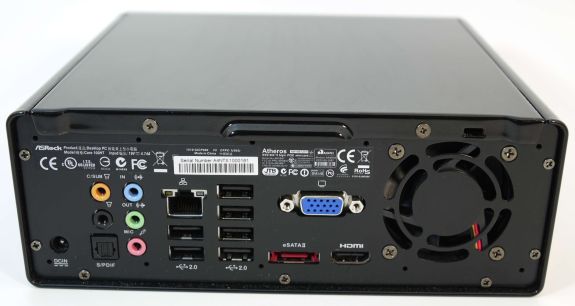ASRock Core 100HT-BD : Bringing HTPCs to the Mainstream Market [UPDATED : Noise Issue]
by Ganesh T S on July 19, 2010 9:34 PM EST- Posted in
- Home Theater
- Arrandale
- ASRock
- Media Streamer
- Core i3
- HTPC
The Core 100 HT-BD comes in a small package, and at first you wonder how such a powerful unit could come in such a small size.
Apart from the main unit, the package also bundles the following:
1. 90W AC / DC Adapter
2. SATA and power cables, as well as mounting screws for an optional second 2.5" hard disk
3. HDMI to DVI adapter
4. MCE remote and batteries.
5. Manual with instructions for disassembling and mounting the optional disk drive
6. Anti-slip pad for the base of the unit
7. CD with drivers and ASRock utilities
The appearance and dimensions of the unit are very similar to that of the ION 330-HT that was reviewed last August. The build quality of the chassis is top notch, and the unit will have no problem in blending with the A/V equipment of most consumers. However, the abrupt edges of the unit will not sit well with those interested more in the aesthetics and appearance rather than the internal capabilities of the unit. In the next iteration of the product, ASRock will probably work on the industrial design a bit more. Replacing the slimline Blu-Ray drive with a slot-loading type drive would also improve the appearance. These types of changes would enable them to cater to the segment of consumers who go more by the looks also.
We had mentioned in the ION 330 review about the absence of ports on the front panel being a bit strange, and ASRock has duly taken note, putting two USB 3.0 ports on the front panel. In addition, we also have headphone and microphone jacks in front. A set of vents on the left of the front panel helps in cooling the unit by maintaining air circulation. The slimline Blu-Ray drive is the same as those which make an appearance in various notebooks. The cost of such drives has come down drastically in the last 1 year, and we don't expect this component to add on too much cost over the DVD drive only version. Notably absent in the ION 330, but making an appearance in this unit is the THX logo above the power button to the right of the front panel.
ASRock uses the two sides of the unit as antennae for the Atheros WiFi module. Moving on to the rear of the unit, we find the adapter power input, followed by the audio ports. Analog audio output can be connected directly to the speakers, or the optical SPDIF output can be used to connect to older A/V receivers. Following this is the Gigabit Ethernet port, and 6 USB 2.0 slots. Further to the right, we have the VGA output (we really needed a DVI here), beneath which one gets the eSATA slot and HDMI output port. Wrapping up this panel is the ventilation fan. Our only gripe with the back panel is the placement of the eSATA port, which makes it difficult to connect external hard disks, particularly when the VGA port is being used.
Just like a notebook, this unit also supports simultaneous display on two monitors. Testing was done mostly with the HDMI output connected to a Toshiba REGZA 37" 1080p TV through an Onkyo TX-SR 606, and the VGA port connected to a old Dell monitor running at 1280x1024. It must be noted that the HDMI port on the unit is only 1.3a. This makes it impossible for the unit to drive monitors with resolutions higher than 1920x1080. Even extremely affordable 2048x1152 monitors such as this one from Dell are left unsupported at their maximum resolutions. However, we expect that this will not be a concern to buyers, since the unit will probably end up getting connected to a 1080p TV in most scenarios.
The Core 100 HT-BD ships with no OS installed. For the purpose of this review, we loaded up a copy of Windows 7 Ultimate x64. It is also possible to install Ubuntu or any other Linux distribution and still be able to take advantage of most of the HTPC functions of the system. Our analysis in the rest of the article, however, is completely from the Windows 7 standpoint.
Starting with this piece, all our media streamer and HTPC reviews will carry a table summarizing the data and A/V connectivity options for the unit from a home theater perspective. We will conclude this section with the same.
| Option | Status |
|---|---|
| HDMI | Yes [v1.3a] |
| Component | No |
| Composite | No |
| VGA | Yes |
| SPDIF | Yes [Optical] |
| Stereo | Yes |
| Option | Status |
|---|---|
| Optical Disk Drive | Yes [Blu-Ray] |
| USB | Yes [6 x v2.0, 2 x v3.0] |
| eSATA | Yes |
| LAN | Yes [ 1000 Mbps GbE ] |
| Internal HDD | Yes [ 500 GB ] |
| WiFi | Yes [ 300 Mbps 802.11n ] |
| Card Reader | No |














107 Comments
View All Comments
spddemon - Thursday, July 22, 2010 - link
That is great news ganeshts.34.5db at 2ft is very quiet to me... with my theater setup you can not even hear my xbox so this would be no problem.
i still want to see the core i3 330 vs 530 tests. I wonder how much faster the 530 is since it is a faster CPU and GPU, but I also wonder how much more power it will consume in typical home theater use.
omems - Thursday, July 22, 2010 - link
This is a really great article, Ganesh. My HTPC is getting a bit old at about 6 years, so I'm definitely ready to upgrade and take advantage of some of the newer technologies which are finally being combined usefully. I have a few questions about how this assembly sleeps:1. When you put it to sleep, which components remain on? Just RAM? Any fans?
2. I believe the Atheros AR9287 supports what they call wake-on-wireless. Does that work in this implementation, from sleep? How about from hibernation?
3. Did you try coming out of Hibernation and seeing if the handshakes were maintained?
4. I am confused by what's going on when you say in the Ease of Use section:
"...ASRock supplies an Instant Boot utility. Using this, whenver [sic] the Core 100 HT-BD is shut down, it boots up once again and shuts down before the power can be safely removed."
Does the instant boot utility bring the machine into the main OS (say Windows) or is it a stripped-down linux environment for simple access to things like music and DVD playback?
If it's the former, what's the point--what does it do that just waking up doesn't? Or is it some kind of middleware to keep maybe the IR and WiFi active?
If it's the latter, what sorts of playback support is there?
I'm mostly concerned with limiting hard drive and power usage, but also being able to quickly resume from a wireless connection. With my current setup (almost 7 years old at its core), I like to send it to Hibernate, and then wake it up via WOL with my iPod or another computer to send new files to over. I avoid sleep because the something (CPU fan and hard drives, if I recall correctly) is still active and it's kind of loud and I worry the drives will wear out faster. I probably could sort it out but why bother when such cool new toys are coming out?
Thanks!
ganeshts - Thursday, July 22, 2010 - link
omems,I will try to handle your queries in a series of replies. In this one, I will let you know things which I know off the top of my head without accessing the unit:
1. Sleep : The fans are completely off. I heard nary a sound from the unit when in sleep mode. I think cross ventilation slots on either side of the RAM modules help. The blue front LED keeps blinking slowly on and off in sleep mode, but you can turn that OFF in the BIOS by Enabling the 'Goodnight LED' option (see BIOS pictures set).
2. Wake on wireless using AR9287 hasn't been tested. I will get back to you on this ASAP.
3. Handshakes are maintained much better than in my ATI based HTPC. My power on sequence when unit is in sleep or hibernate or complete shutdown mode (as long as AC adapater is connected to unit) is as follows: Power on TV and put it it in AV receiver input mode -> Power on Receiver -> Press Power button on MCE remote. Display comes out perfectly on TV every time I followed this sequence.
4. InstantBoot : Look at the coverage on ZDNet here: http://www.zdnet.com/blog/hardware/asrock-4-second... ; I think their explanation and analysis would be much better than what I can do in this space :)
Will provide more info within a day or so.
ganeshts - Thursday, July 22, 2010 - link
omems,ASRock reports that only the AR9280 and AR9281 support Wake-On-Wireless. Unfortunately, the add on card in Core 100 is the AR9287.
I am not sure how you wanted to use the 'wake on wireless' feature, but I would say that using the MCE remote to wake up the unit is the easiest and most simple.
omems - Monday, July 26, 2010 - link
Thanks, Ganesh, for all the additional info.I plan to use the wake on wireless when the HTPC is asleep and I'm at another computer in the house and want to move newly-acquired media to the HTPC without having to go to that room and wake it up.
I suppose it's not a deal breaker though if the included card doesn't support it. I could use encouragement to get off my butt now and again.
The insantBoot sounds like an interesting hybrid concept. Thanks for the link.
Cheers
ganeshts - Monday, July 26, 2010 - link
omems, I did see an option in the BIOS to enable / disable 'Wake-On-LAN'. So, if this unit is going to be connected to a wired network, you might still find it hard to get off your couch / chair / bed :Dvlado08 - Thursday, July 22, 2010 - link
Ganesh on page 5 you say:"We did observe red spikes, but disabling the C-states, as well as SpeedStep in the BIOS Advanced CPU configuration helped in alleviating the issue."
On page 11 you say:
"At idle, the system consumed around 18 W."
1) Is this DC power or is this AC power measured at wall outlet?
2) Is 18W idle power with enabled C-states and SpeedStep?
3) And if yes then what is the idle power when disabling the C-states, as well as SpeedStep?
ganeshts - Thursday, July 22, 2010 - link
vlad08,The quoted power numbers are measured AC power using Kill-a-Watt over a 6 hour usage period.
18W idle power is with C-state and SpeedStep enabled. I will quote idle power numbers with them disabled after testing out tonight.
ganeshts - Friday, July 23, 2010 - link
vlado08,The idle power consumption with both C-states and SpeedStep disabled is 21.6W.
The CPU wasn't overclocked (it idled at 2.14 GHz).
Regards
Ganesh
vlado08 - Friday, July 23, 2010 - link
Thanks Ganesh.So it is still less than the ion 330 idle power - 28,6W according to:
http://www.anandtech.com/show/2828/8
If only Intel team resolve the 23,976hz issue .....
I am still waiting because for me this is more important than bitsreaming